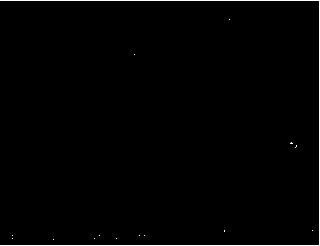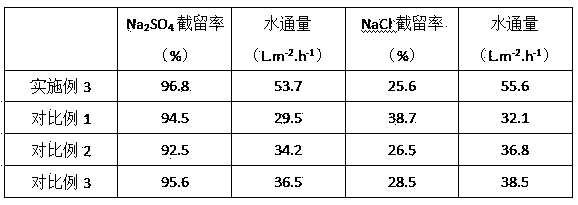Preparation method of sulfonic acid type amphoteric polyelectrolyte nanoparticle hybrid polyamide nanofiltration membrane
A nanoparticle and polyelectrolyte technology, applied in chemical instruments and methods, membrane technology, semipermeable membrane separation, etc., can solve problems such as easy aggregation, high manufacturing cost of nanomaterials, and membrane defects, so as to improve transmission efficiency, high water Effect of permeability and stain resistance, good stain resistance
- Summary
- Abstract
- Description
- Claims
- Application Information
AI Technical Summary
Problems solved by technology
Method used
Image
Examples
preparation example Construction
[0018] The preparation method of the sulfonic acid type amphoteric polyelectrolyte nanoparticle hybrid polyamide nanofiltration membrane comprises the following steps:
[0019] (1) Dissolve 10-30 parts by mass of sulfobetaine monomer and 5-10 parts by mass of cationic monomer in 50-200 parts by mass of an aqueous solution, blow nitrogen into it, and add 0.1-1 part by mass of water-soluble Initiator, at 40-60 o Polymerize at C for 6-12 hours, precipitate the polymer with acetone, and wash it several times to obtain a sulfonic acid-type amphoteric cationic polymer, which is vacuum-dried for later use;
[0020] (2) Dissolve 1 to 3 parts by mass of sodium carboxymethylcellulose and 0.5 to 2 parts by mass of sulfonic acid type amphoteric cationic polymer in 100 to 500 parts by mass of acidic aqueous solution, and then dissolve the sulfonic acid type amphoteric cationic polymer The acidic aqueous solution of the polymer is added dropwise into the acidic aqueous solution of sodium c...
Embodiment 1
[0024] 10 g of 3-[N,N-dimethyl-[2-(2-methylprop-2-enoyloxy)ethyl]ammonium]propane-1-sulfonic acid inner salt and 5 g of methacrylic acid Dissolve acyloxyethyltrimethylammonium chloride in 50 g of aqueous solution, pass through nitrogen, add 0.1 g of potassium persulfate and sodium bisulfite (mass ratio is 1:1), at 40 o C was polymerized for 12 hours, precipitated with acetone, washed several times, and vacuum-dried to obtain a sulfonic acid type amphoteric cationic polymer; 1 g of sodium carboxymethyl cellulose and 0.5 g of sulfonic acid type amphoteric cationic polymer were dissolved in In 100 g of 0.01wt% hydrochloric acid aqueous solution, the acidic aqueous solution of sulfonic acid type amphoteric cationic polymer is added dropwise in the acidic aqueous solution of sodium carboxymethyl cellulose to carry out ionic crosslinking, through precipitation, washed with deionized water several times, in 40 o C dried for 16 hours to obtain sulfonic acid type amphoteric polyelectr...
Embodiment 2
[0027] 30 g of 3-[N,N-dimethyl-[2-(2-methylprop-2-enoyloxy)ethyl]ammonium]propane-1-sulfonic acid inner salt and 10 g of methacrylic acid Dissolve acyloxyethyltrimethylammonium chloride in 200 g of aqueous solution, blow nitrogen gas, add 1 g of potassium persulfate and sodium bisulfite (mass ratio: 1:1), at 60 o C was polymerized for 6 hours, precipitated with acetone, washed several times, and dried in vacuum to obtain a sulfonic acid type amphoteric cationic polymer; 3 g of sodium carboxymethyl cellulose and 2 g of sulfonic acid type amphoteric cationic polymer were dissolved in In the 0.1wt% hydrochloric acid aqueous solution of 500 g, the acidic aqueous solution of sulfonic acid type amphoteric cationic polymer is added dropwise in the acidic aqueous solution of carboxymethylcellulose sodium to carry out ion cross-linking, through precipitation, wash with deionized water several times, in 60 o C dried for 8 hours to obtain sulfonic acid type amphoteric polyelectrolyte na...
PUM
| Property | Measurement | Unit |
|---|---|---|
| retention rate | aaaaa | aaaaa |
Abstract
Description
Claims
Application Information
 Login to View More
Login to View More - R&D
- Intellectual Property
- Life Sciences
- Materials
- Tech Scout
- Unparalleled Data Quality
- Higher Quality Content
- 60% Fewer Hallucinations
Browse by: Latest US Patents, China's latest patents, Technical Efficacy Thesaurus, Application Domain, Technology Topic, Popular Technical Reports.
© 2025 PatSnap. All rights reserved.Legal|Privacy policy|Modern Slavery Act Transparency Statement|Sitemap|About US| Contact US: help@patsnap.com



